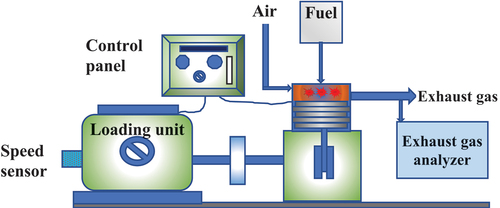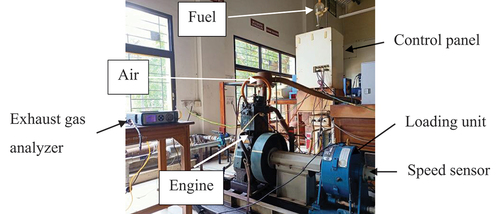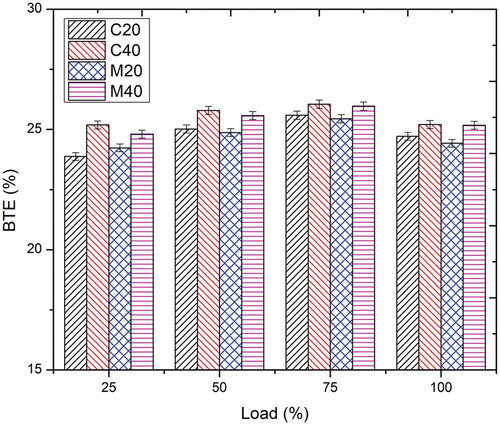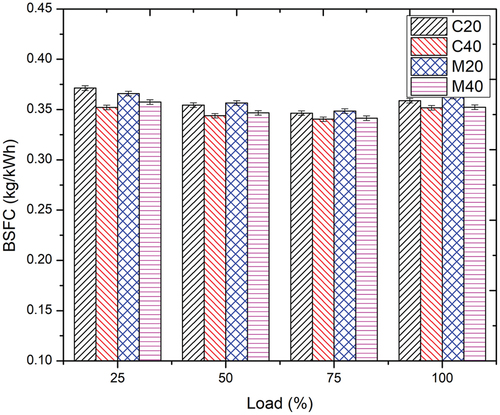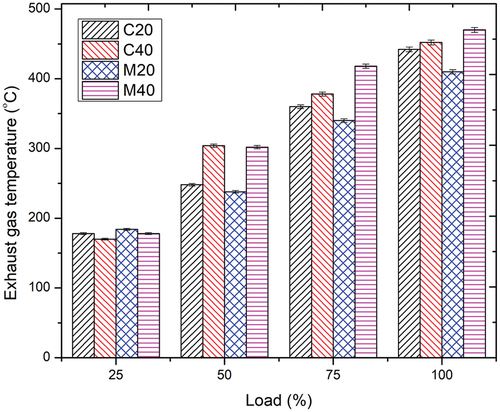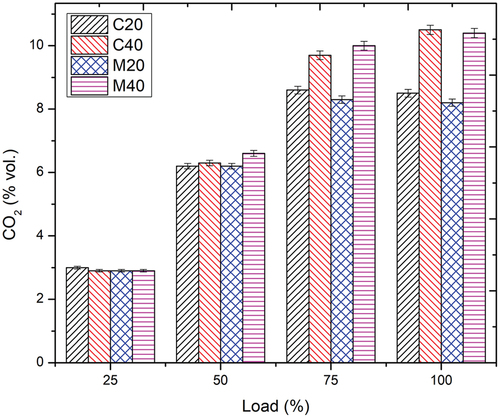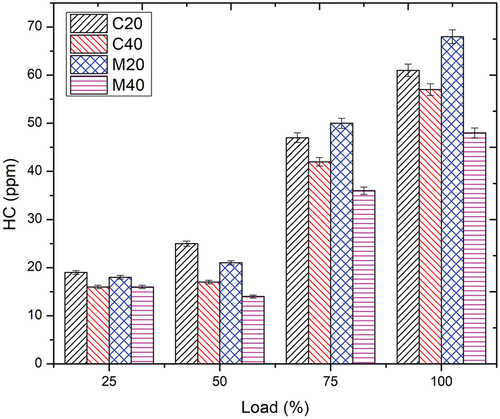Abstract
The quest for energy efficiency systems is gaining momentum in the present-day context due to prevailing environmental and eco nomic compulsions. One of the alternatives available to meet this requirement is to modify the fuel to make it greener and more reasonable. In the present study, an attempt has been made to assess the performance and emissions of a compression ignition (CI) engine fuelled with B20 biodiesel and nano additives. Experiments have been carried out on a ssingle-cylinder CI engine using waste cooking oil-derived biodiesel, B20 and nano-sized biochar and multi-walled carbon nano tubes (MWCNTs). The nano additives were used in concentrations of 20 and 40 ppm to form four fuel variants, and the results relating to performance and emissions were compared. B20 fuel with MWCNT nanoparticles showed better brake thermal efficiency (BTE), brake-specific fuel consumption and reduced HC and carbon monoxide emissions. On the contrary, increased exhaust temperature and a subsequent increase in NOx emissions were recorded. The activated biochar nanoparticles improved the BTE of the engine with a comparatively better removal of NOx. This intricate behaviour of both the carbon nanoparticles reported in this work requires comprehensive optimization studies in the future.
1. Introduction
In the present scenario, nanotechnology plays a vital role in several energy-related applications. This can be attributed to their superior heat carrying capacity coupled with catalytic behaviour leading to enhanced energy conversion. In combustion-related aspects, nanoparticles are becoming a promising alternative not only to improve energy conversion efficiency but also to reduce emissions (Moorthi et al., Citation2022). Nanoparticles are broadly classified as metallic and non-metallic, both being extensively used to improve engine combustion (Hosseinzadeh-Bandbafha et al., Citation2023; Singh et al., Citation2022). However, due to higher melting point of metallic nanoparticles, in the long run, they remain not only in piston crevices but also in tailpipe leading to higher wear and tear of engine components and get discharged to the environment through exhaust gas. Non-metallic nanoparticles generally have lower melting temperature, due to which they are combustible with fuel without leaving any traces.
The use of nanoparticles in spark ignition engines is not encouraging due to the fuel behaviour and mode of combustion. This may be attributed to the higher volatility and lower viscosity of the fuel leading to the separation of nanoparticles from the air–fuel mixture. In contrast to the above phenomena, in compression ignition (CI) engines, the lower volatility coupled with higher viscosity of the fuel facilitates improved penetration and uniform distribution, thereby leading to more complete combustion (Fayaz et al., Citation2021; Kaushik et al., Citation2022; Kumar et al., Citation2019; Mohan & Dinesha, Citation2022).
Several studies carried out on the usage of nanoparticles in CI engines reveal improved combustion with reduced emissions (Bhan et al., Citation2022; Patel & Dhiman, Citation2022; Sarma et al., Citation2023). Uslu et al. investigated the performance and emissions of a diesel engine using cerium oxide as an additive (Uslu & Celik, Citation2023). Their study carried out using different sizes and concentrations of nanoparticles revealed that a concentration of 100 ppm has resulted in 9.8% increase in brake thermal efficiency (BTE) and a substantial reduction in carbon monoxide (CO), HC and smoke emissions. Al-Dawody and Edam (Citation2022) carried out performance and emissions study on a diesel engine fuelled with 20% castor oil methyl ester (B20) with alumina nanoparticles in three doses (25, 50 and 100 ppm). They report that the dosage of 25 ppm has resulted in superior performance and reduced emissions. Pourhoseini et al. investigated the effect of iron nanoparticles with B20 biodiesel derived from palm oil in a CI engine under low temperature and cold start conditions (Pourhoseini et al., Citation2023). The study concluded with the improved combustion parameters coupled with lower emissions.
The influence of non-metallic nanoparticles such as multi-walled carbon nano tube (MWCNT) has also resulted in improved BTE and reduced CO, HC and smoke emissions in CI engine (Mohan et al., Citation2022). Solmaz et al. (Citation2023) used 100 ppm MWCNT nanoparticles with B20 biodiesel and observed higher BTE and lower exhaust emissions compared to neat B20. Madhuri and Swarna Kumari (Citation2023) investigated the effect of MWCNT nanoparticles with B20 biodiesel blend in a CRDI engine and found superior engine performance and emission characteristics. The use of MWCNT nanoparticles increases the heat liberation rate and peak cylinder pressure with lower tailpipe emissions (Xuan et al., Citation2023). Similar results were reported by Nachippan et al. (Citation2022) in a CI engine fuelled with MWCNT and B20 biodiesel combination.
The literature review reveals that the use of both metallic and non-metallic nanoparticles in CI engine results in improved performance and emissions. However, the long-run study on their effect on environment and their economic viability aspects is rather scanty, especially with regard to metallic nanoparticles. In the present study, an attempt has been made to investigate the influence of waste biomass-derived eco-friendly nanoparticles (activated biochar) on the performance and emissions in a CI engine fuelled with B20 biodiesel derived from waste cooking oil. The results were compared with MWCNT nanoparticles-mixed B20 biodiesel fuel blend and baseline B20 biodiesel operation.
2. Materials and methods
Biodiesel derived from waste cooking oil is procured from the nearby State-run biofuel development centre. A standard blend of B20 is prepared by mixing it with mineral diesel. The properties of the fuel sample are depicted in Table . The activated biochar produced from coconut shell (<100 nm) and MWCNT (10–20 nm) were procured from a standard vendor. Separate blends of B20 with biochar and MWCNT in concentrations of 20 and 40 ppm were prepared. Then, stirring was carried out in an Ultrasonicator to ensure uniform miscibility. Thereafter the sample was immediately used in the test rig for experimentation. The details of the fuel blends used are presented in Table .
Table 1. Physico-chemical properties of the fuel blend
Table 2. Details of the fuel blends used
A single-cylinder, naturally aspirated, water-cooled 5.2 kW peak power output CI engine operating at a constant speed of 1500 rpm was used for experimentation. The experiments were performed at varying load conditions using an eddy current dynamometer. The schematic diagram and photograph of the engine setup are depicted in Figures , respectively. The specifications are shown in Table . The readings were tabulated after ascertaining the steady-state condition by observing the exhaust gas temperature (EGT). Exhaust gas concentrations were recorded using the AVL five gas analyser. The correctness of the recorded values was ensured by carrying out uncertainty analysis. The uncertainty analysis enables smoothening experimental errors related to instrumentation. The independent parameters considered in uncertainty analysis are engine speed, fuel flow and applied brake load. The uncertainty parameters are shown in Table .
Table 3. Specifications of the engine setup
Table 4. Values of uncertainties of the measured parameters
3. Results and discussion
3.1. BTE and brake-specific fuel consumption
The BTE of the engine for all four different fuels are compared in Figure . The BTE increases with the increase in the load up to 75%, and at 100% load, a slight decrease in the BTE is obtained. The highest BTE of 26.05% is seen with the activated biochar nanoparticle in the biodiesel having 40 ppm concentration (C40). A similar level of BTE (25.97%) is also seen with 40 ppm of MWCNT (M40). When the concentration of nanoparticles is 20 ppm, the BTE is lowered. When compared to C20, an increase by 3.1% in the BTE was seen with C40. However, when compared to the M40 blend, the C40 blend showed a marginal difference in the BTE but was higher than M40 at all the loads. The overall average change in BTE of C40 over M40 blend was 0.69%. A similar trend is obtained for the brake-specific fuel consumption (BSFC). The lowest average BSFC is obtained for C40 followed by M40, C20 and M20. An increase in the load of up to 75% decreases the BSFC of the fuel for all the blends. The lowest BSFC of 0.34 kg/kWh is recorded for C40 at 75% loading. A comparison of BSFC of all the fuel blends is shown in Figure .
3.2. EGT
The EGT is an indication of complete combustion. Figure shows the EGT of the different blends at varying loads. The highest EGT of 470°C is seen for M40 blend followed by C40, C20 and M20. With the increase in the MWCNT nanoparticle concentration from 20 to 40 ppm, the average increase in the EGT is 15.3%. The average increase of 6.33% in EGT is seen with the increase in the biochar concentration from 20 to 40 ppm. The EGT increases with the increase in the brake loads. Overall, MWCNT nanoparticles seem to have been a better choice than the activated char in ascertaining the complete combustion of the fuel. The increase in the cetane number, heat transfer coefficient and reduced ignition delay due to the addition of MWCNT nanoparticles promote complete combustion of the fuel. In addition, the MWCNT nanoparticles have a high surface area suitable for promoting completing combustion. Increasing the concentration of the activated biochar also increases the EGT. This may be due to the high reactive surface area of the char nanoparticles on which a more complete combustion may be promoted. The char may act as a catalyst, and due to the activation of the biochar, there may have been a selectivity of combustion reactions occurring on the active surface area of the char.
3.3. CO emissions
The CO gas occurs as an intermediate product of incomplete combustion. Decrease in CO emissions is obtained with the addition of both MWCNT and activated biochar nanoparticles. Increasing the brake load of the engine increases the emissions due to additional fuel flow rate at higher loads. At 100% load, the lowest CO emissions of 1.3 %vol. is seen with the M40 blend. The corresponding values of CO emissions for C40, C20 and M20 blends are 1.56 %vol., 1.87 %vol. and 2.24 %vol., respectively. It is seen that the biochar blends of both 20 and 40 ppm concentrations have fared better than the baseline B20 and the M20 blend. Figure shows the CO emissions obtained in this work for varying loads and blends.
3.4. CO2 emissions
Higher CO2 emissions are desirable as CO2 is the expected end product formed from complete hydrocarbon combustion. Figure shows the CO2 emissions obtained in this study for varying blends and engine loads. At 100% brake load, the highest CO2 emissions are obtained when the concentration of nanoparticles is 40 ppm (10.4 %vol. for MWCNT and 10.5 %vol. for activated biochar). The average emissions for C20, C40, M20 and M40 are, respectively, 6.58 %vol., 7.35 %vol., 6.4 %vol. and 7.48 %vol. Overall, M40 shows the highest CO2 emissions. The emissions of CO2 usually have a reversing trend compared to CO emissions. This is because, lower CO emissions may be attributed to a more complete combustion of the fuel resulting in higher CO2 emissions. The CO formed as an intermediate compound will further oxidize to form CO2, thereby increasing the concentration of CO2 in the exhaust. Both the MWCNT and activated biochar nanoparticles provide excellent reactive surface area for promoting the completion of the combustion process. In addition to the nanoparticles acting as a catalyst, MWCNT in particular has the property to reduce ignition delay as well as increase the heat transfer coefficient, which promotes better combustion.
3.5. HC emissions
The HC emissions have a similar trend as that of the CO emissions. Figure shows the comparison of HC emissions of the fuel blends at different engine loads. An increase in the brake load of the engine is increasing the HC emissions due to the higher amount of fuel intake at higher loads. However, upon careful observation, it is clear that the addition of the nanoparticles in the fuel significantly reduces the HC emissions. This trend is evident for both the activated biochar and MWCNT nanoparticles. The lowest emission is recorded for the M40 blend having 40 ppm concentration of MWCNT nanoparticles. With the addition of 40 ppm of activated char nanoparticles, the HC emissions have reduced by 13% as compared to the 20 ppm blend. On the contrary, MWCNT nanoparticles showed a reduction of 27% when 40 ppm concentration is used instead of 20 ppm. As is seen with the reduction in CO emissions, both types of nanoparticles provide active surface area for improved combustion. Hence the hydrocarbons combust more efficiently improving the overall process. MWCNT nanoparticles also have the capacity to store oxygen and therefore M40 blend having higher concentration of MWCNT nanoparticles demonstrates a better trend in the HC emissions. Although M40 seems a superior choice of additive, MWCNT nanoparticles cannot be directly preferred as M20 has shown higher emissions compared to C20 nanoparticles. Hence, an optimization study on the same will aid in deciding the preferred type of additive and concentration.
3.6. NOx emissions
Figure shows the emissions of NOx obtained in this work for varying loads and fuel blends. A contrasting trend in the results has been observed, similar to our previous work (Mohan et al., Citation2022). The average NOx emissions from all the loads in the increasing order are C40 (1032 ppm), M20 (1035 ppm), C20 (1081 ppm) and M40 (1113 ppm). The emissions of NOx increase when the brake load is increased up to 75%. The lowest NOx at all loads is observed for C40 blend. In comparison, M40 showed the highest values of NOx. This trend is observed as MWCNT nanoparticles have an active surface area that promotes complete combustion which is augmented by higher heat transfer coefficient and oxygen storage capacity. Higher oxygen concentrations have improved the combustion resulting in the improvement in the BTE and BSFC in conjunction with the reduction of CO and HC emissions. It is also evident from the trend of the EGT that higher temperature due to improved combustion is obtained. At the comparatively higher temperature along with the additional oxygen storage available due to the MWCNT nanoparticles, higher NOx formation has been ensued with the M40 blend.
4. Conclusions
The present study carried out a comparative analysis of implementing activated biochar and MWCNT as nanoparticle additives in B20 fuel in a CI engine. The following conclusion can be drawn from the investigation:
The addition of activated biochar and MWCNT nanoparticles has significantly improved the brake performance of the engine.
The highest BTE of 26.05% is obtained for C40 fuel, which is in close proximity to M40 fuel that returned with an efficiency of 25.97%.
The MWCNT nanoparticles with 40 ppm concentration resulted in the lowest emissions of CO and HC emissions owing to their better heat transfer characteristics and active surface area compared to activated biochar.
Due to the higher temperatures, MWCNT with 40 ppm showed an increase in the NOx emissions compared to activated biochar operation.
Although both the additives were carbon nanoparticles, contrasting results obtained in this work would require a comprehensive optimization studies to assess the intricate behaviour.
Disclosure statement
No potential conflict of interest was reported by the author(s).
References
- Al-Dawody, M. F., & Edam, M. S. (2022). Experimental and numerical investigation of adding castor methyl ester and alumina nanoparticles on performance and emissions of a diesel engine. Fuel, 307, 121784. https://doi.org/10.1016/j.fuel.2021.121784
- Bhan, S., Gautam, R., Singh, P., & Sharma, A. (2022). A comprehensive review of performance, combustion, and emission characteristics of biodiesel blend with nanoparticles in diesel engines BT. In L. M. Das, A. Sharma, F. Y. Hagos, & S. Tiwari (Eds.), Recent trends in thermal Engineering (pp. 73–10). Springer Singapore.
- Fayaz, H., Mujtaba, M. A., Elahi M Soudagar, M., Razzaq, L., Nawaz, S., Muhammad Ahsan Nawaz, M. F., Afzal, A., Waqar Ahmed, T. M. Y. K., Ahmed, W., Khan, T. M. Y., Bashir, S., Yaqoob, H., EL-Seesy, A. I., Wageh, S., Al-Ghamdi, A., & Elfasakhany, A. (2021). Collective Effect of ternary nano fuel blends on the diesel engine performance and emissions characteristics. Fuel, 293, 120420. https://doi.org/10.1016/j.fuel.2021.120420
- Hosseinzadeh-Bandbafha, H., Kazemi Shariat Panahi, H., Dehhaghi, M., Orooji, Y., Shahbeik, H., Mahian, O., Karimi-Maleh, H., Abul Kalam, M., Salehi Jouzani, G., Mei, C., Nizami, A.-S., Guillemin, G. G., Gupta, V. K., Lam, S. S., Yang, Y., Peng, W., Pan, J., Kim, K.-H., Aghbashlo, M., & Tabatabaei, M. (2023). Applications of nanotechnology in biodiesel combustion and post-combustion stages. Renewable and Sustainable Energy Reviews, 182, 113414. https://doi.org/10.1016/j.rser.2023.113414
- Kaushik, Y., Verma, V., Saxena, K. K., Prakash, C., Gupta, L. R., & Dixit, S. (2022). Effect of Al2O3 nanoparticles on performance and emission characteristics of diesel engine fuelled with diesel–neem biodiesel blends. Sustainability. https://doi.org/10.3390/su14137913
- Kumar, S., Dinesha, P., & Rosen, M. A. (2019). Effect of injection pressure on the combustion, performance and emission characteristics of a biodiesel engine with cerium oxide nanoparticle additive. Energy, 185, 1163–1173. https://doi.org/10.1016/j.energy.2019.07.124
- Madhuri, R. V. S., & Swarna Kumari, A. (2023). Influence of fuel components, injection parameters and nano blends on CRDI engine characteristics fuelled with palm and Jatropha Methyl Esters. International Journal of Ambient Energy, 44(1), 256–269. Taylor and Francis Ltd. https://doi.org/10.1080/01430750.2022.2126522
- Mohan, S., & Dinesha, P. (2022). Performance and emissions of biodiesel engine with hydrogen peroxide emulsification and cerium oxide (CeO2) nanoparticle additives. Fuel, 319, 123872. https://doi.org/10.1016/j.fuel.2022.123872
- Mohan, S., Dinesha, P., & Aiswarya, V. (2022). Synergetic influence of hydrogen peroxide emulsification and MWCNT nanoparticles to reduce engine exhaust emissions using B20 biodiesel blend. International Journal of Hydrogen Energy, 47(51), 21863–21877. https://doi.org/10.1016/j.ijhydene.2022.05.016
- Moorthi, M., Murugesan, A., & Alagumalai, A. (2022). Effect of nanoparticles on DI-CI engine characteristics Fueled with biodiesel–diesel blends—A critical review. Journal of Thermal Analysis and Calorimetry, 147(17), 9163–9179. https://doi.org/10.1007/s10973-022-11234-6
- Nachippan, N. M., Parthasarathy, M., Elumalai, P. V., Backiyaraj, A., Balasubramanian, D., & Tuan Hoang, A. (2022). Experimental assessment on characteristics of premixed charge compression ignition engine fueled with multi-walled carbon nanotube-included Tamanu methyl ester. Fuel, 323, 124415. https://doi.org/10.1016/j.fuel.2022.124415
- Patel, K. R., & Dhiman, V. D. (2022). Effect of hybrid nanoparticles MgO and Al2O3 added water-in-diesel emulsion fueled diesel engine using hybrid deep neural network-based spotted hyena optimization. Heat Transfer, 51(6), 5748–5788. John Wiley & Sons, Ltd. https://doi.org/10.1002/htj.22568
- Pourhoseini, S. H., Ghodrat, M., Baghban, M., & Shams, Z. (2023). Effects of blending energetic iron nanoparticles in B20 fuel on lower CO and UHC emissions of the diesel engine in cold start condition. Case Studies in Thermal Engineering, 41, 102658. https://doi.org/10.1016/j.csite.2022.102658
- Sarma, J., Chinmoy, P. S., Jyoti Bora, B., Bora, D. K., Senthilkumar, N., Balakrishnan, D., & Ayesh, A. I. (2023). Improving the combustion and emission performance of a diesel engine powered with mahua biodiesel and TiO2 nanoparticles additive. Alexandria Engineering Journal, 72, 387–398. https://doi.org/10.1016/j.aej.2023.03.070
- Singh, Y., Pali, H. S., Singh, N. K., Sharma, A., & Singla, A. (2022). Effect of nanoparticles as additives to the Biofuels and their feasibility assessment on the engine performance and emission analysis—A review. Proceedings of the Institution of Mechanical Engineers, Part E: Journal of Process Mechanical Engineering, 237(2), 492–510. IMECHE. https://doi.org/10.1177/09544089221109723
- Solmaz, H., Calam, A., Yılmaz, E., Şahin, F., Mohammad Safieddin Ardebili, S., & Aksoy, F. (2023). Evaluation of MWCNT as fuel additive to diesel–biodiesel blend in a direct injection diesel engine. Biofuels, 14(2), 147–156. Taylor and Francis Ltd. https://doi.org/10.1080/17597269.2022.2122154
- Uslu, S., & Celik, M. (2023). Response surface methodology-based optimization of the amount of cerium dioxide (CeO2) to increase the performance and reduce emissions of a diesel engine fueled by cerium dioxide/diesel blends. Energy, 266, 126403. https://doi.org/10.1016/j.energy.2022.126403
- Xuan, T., Abdullah, A. S., He, Z., Mujtaba, M. A., Veza, I., & Ahmed, I. E.-S. (2023). Enhancement of the applicability of jatropha biodiesel in a diesel engine using N-Heptanol and multiwalled carbon nanotube additives. International Journal of Ambient Energy, 1–12. https://doi.org/10.1080/01430750.2023.2224336

